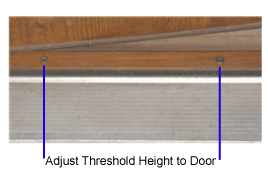
Options on How to Seal a Door Bottom To Insulate
There are three basic options used to insulate an exterior door at the bottom.
Each has its own level of difficulty, while much will depend on the type and
brand of door you have, and, on the availability of compatible parts.
First check the seal at the door threshold, and if you have adjustable screws for raising and lowering
the strip to change the bottom gap (some thresholds are adjustable and some are not). See if the gap might
be closed, if perhaps it was never set right, has moved with time, or whether it could make up for a wearing seal -- though
installing a new seal is optimal.
Replacing Door Seal at Bottom - Many exterior doors come with factory seals at the
bottom edge. Once they wear, it is normally recommended to check the door maker for a replacement match.
Exhausting this option, check for a compatible piece. To replace this seal;
1) Remove the door from its hinges and place on a level surface at working height. Verify that the seal you
have for replacement will fit, especially if it is made to fit several door types. This includes whether the new attachments
will fit properly on your door.
2) The seal will be either stapled or screwed in from the bottom edge. These must be removed.
Pull loose and detach this seal.
3) Measure and cut the new weather stripping to fit with heavy scissors or a utility knife.
4) Re-attach the seal and then replace the door on its hinges. Swing it shut, gauging the seal. It may close tighter
than what you are used to, at first. Additionally, the weather stripping may have to be broken in.
Before undertaking this procedure, when checking with your door maker, you should to pull the door ahead of time to
confirm parts. Also check about a threshold insert if it shows signs of wear or deterioration. At times, replacement pieces
might be of higher quality and design, based on your particular door.
Replacing Threshold Inserts - Combined with the door seal, the total seal
formed at the threshold acts to block the passage of air, dust and the elements. The inserts,
made of vinyl, are a high wear item and are subject to intense foot traffic.
The inserts are basically placed within existing thresholds, of a design that secures
them with an integrated retainer, and overall they do work well.
However often the real challenge lies in finding a replacement that will fit the profile of threshold
you happen to have, these are made to fit aluminum or hardwood thresholds of various models.
Note that some doors are equipped with adjustable height thresholds, and so this
should be looked at when door seals seem adequate prior to any replace and for
any finish adjustment.
Installing A Door Sweep - Relatively easy to install, the door sweep is mounted on
the interior, is screw mounted to the door and can insulate with some benefits.
To attach the screw mounted seal:
1) Measure the door width for the desired length. Next, accounting for any necessary end gaps, cut the aluminum strip with a hacksaw
or metal cutting saw and the vinyl with a sharp blade.
2) Hold the cut sweep level on the door, and mark the holes. It's generally a good idea to first place blue tape on the door
for clear marking and to easily move positioning, as many can be adjusted.
3) Pre-drill the holes with an appropriate bit for the door surface being drilled, be it wood, metal or fiberglass.
Though once drilled, these are difficult to patch.
4) Be sure to adjust the clutch on your drill, and screw fasten
the sweep to the inner bottom edge.
5) Test the door by swinging it all the way open and shut.

